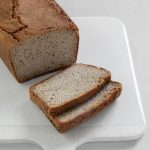Buckwheat Quinoa Bread
This buckwheat quinoa bread has a slightly tangy flavor and a hearty texture with a firm crust and a moist, soft interior. It's essentially sourdough bread without a sourdough starter.
Servings: 16 slices
Calories: 98kcal
Ingredients
- 2 1/4 cups buckwheat groats
- 1/2 cup quinoa
- 1 1/4 cups water
- 3/4 tsp. sea salt
Instructions
- Soak the buckwheat and quinoa. Add the buckwheat and quinoa into a large bowl, cover them with water, and let them soak for 4-6 hours (ideally, no longer than 8 hours) at room temperature. Then, drain the soaking water and rinse the seeds under lukewarm running water.
- Sprout the buckwheat and quinoa (optional). Transfer the soaked buckwheat and quinoa to a strainer and set the strainer over a large bowl to drain any excess water. If using a sprouting jar, invert it into a large bowl or other object that allows it to sit at an angle. After 8-12 hours, sprouts should start to emerge. If there are no sprouts, drain, rinse, and leave the seeds sprouting for 6-8 more hours. While sprouting is not necessary, it does boost fermentation activity.
- Blend. Add the sprouted (or just soaked) buckwheat and quinoa to a high-speed blender together with water and blend until smooth. The batter might be slightly gritty, but no seeds should be visible.
- Ferment. Transfer the batter to a clean bowl, cover it with a cheesecloth, and let it ferment for about 14 hours at 80°F/27°C. The fermentation time will depend on the temperature - the fermentation rate accelerates as temperature increases. You are looking for the volume of the batter to increase by about a third and for lots of air bubbles on top and throughout the batter.
- Proof. At the end of the fermentation, gently mix in the salt, preserving as much volume and air bubbles as possible. Pour the batter into a parchment paper-lined 8 x 4 inch/20 x 10 cm loaf pan and let it rise for 30-60 minutes. Ensure you don't over-proof the bread; otherwise, the center will collapse during baking.
- Bake. Slide the loaf pan into the oven and bake the bread at 350ºF/177ºC until the bread pulls away from the sides of the loaf pan and the crust turns golden brown, for about 90 minutes.
- Cool. Transfer the bread onto a cooling rack and let it cool completely before slicing. Cutting fresh-baked bread too early will result in a gummy and sticky interior.
- Store. Wrap the bread in a large tea towel (so it can breathe) and store it in a cool place for up to 3 days. For longer-term storage, slice the bread first and then transfer individual slices into an airtight bag, one on top of the other, in an alternating 90-degree pattern. Freeze for up to 3 months.
Notes
*Prep time does not include sprouting the buckwheat and quinoa.
**Nutrition information is approximate and may contain errors. Please feel free to make your own calculations.
Nutrition
Serving: 1of 16 | Calories: 98kcal | Carbohydrates: 19g | Protein: 5g | Fat: 0.8g | Fiber: 4g | Sugar: 0.2g
